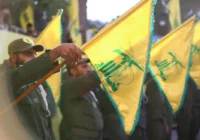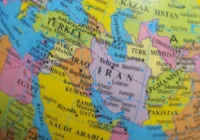The bitter rivalry between Iran and Saudi Arabia is causing further instability in an already explosive Middle East.
Modern relations between Iran and Saudi Arabia have been awash with ups and downs, and a ceaseless competition over the leadership of the Muslim world. Iran is the world’s largest Shia Muslim country with ambitions for boasting the headship of the umma, and Saudi Arabia takes pride in hosting the two holiest Islamic sites in Mecca and Medina. Beyond that, the two oil-rich OPEC members have time and again raced to take the lead in dominating the global energy markets. In fact, their competitiveness has often contributed to unusual fluctuations in crude oil prices and instability in the Middle East.
However problematic the relations between Tehran and Riyadh, the two arch-rivals maintained a policy of mutual tolerance and reluctant restraint over the years, mostly because Iran sends hundreds of thousands of pilgrims to Saudi Arabia on an annual basis—pilgrims who are known for spending lavishly while attending religious rituals. Even at the height of tensions between the two nations, demand for pilgrimage never subsided.
In total, approximately 500,000 Iranians take up the optional Umrah pilgrimage every year. Coupled with about 100,000 Iranians who travel to Saudi Arabia for the compulsory Hajj, Iran’s delegation of pilgrims is indispensable to the Saudis, bringing in millions if not billions of dollars.
For a country that raises anywhere between 3% and 7% of its GDP through “religious tourism,” Iranian pilgrims are considered a major source of income for Saudi Arabia. Local sources in Iran have estimated that Saudi Arabia earns around $405 million every year just on the enlistment and accommodation services it provides for Iranians, as well as the flights operated by the Saudi airlines that take Iranian pilgrims to Jeddah and Medina; the money Iranians spend on phone bills, souvenirs and shopping is excluded.
Even though there have been intermittent reports of disrespect and harassment against Iranian pilgrims in Saudi Arabia, the two nations implicitly agreed to cooperate and bitterly disregard their differences so that Hajj and Umrah programs can be maintained.
How tensions surged
Over the years, there have been incidents and developments that fanned the flames of hostility between Iran and Saudi Arabia, leading to the severing of diplomatic ties on January 3.
Since serious nuclear negotiations between Iran and the P5+1 began in November 2013, the Saudis felt some uneasiness and anxiety at the prospect of a new opening in Tehran’s ties with the West. An opening that could undermine Saudi Arabia’s regional hegemony, and help Iran reemerge as an economic power in the Middle East and forge closer ties with Washington. Besides, the Saudis were scared that a powerful Iran would be able to bolster Shia Islam in the Muslim world, something that would be utterly intolerable for Sunni Saudi Arabia.
Before pen met paper, Riyadh had openly voiced its opposition to a nuclear deal. Saudi Arabia tried its best to convince the Obama administration that an agreement with Iran would be detrimental to US interests—a call the Americans did not heed. Saudi Arabia’s fierce opposition to the Iran deal was one reason that made Iranians pessimistic about the intentions of Saudis and their goodwill as a neighbor.
In March 2015, it was reported that Saudi security guards at Jeddah Airport sexually assaulted two Iranian teenage boys, after separating them from other passengers for “body searches.” The teenagers reported the harassment upon returning to Iran, and one month later, amid the unappeasable outrage of the public, the Iranian Ministry of Culture announced that it would suspend Umrah flights to Saudi Arabia until the offending guards were punished.
On September 24, 2015, a human tragedy, which was apparently triggered by negligence and mismanagement with no obvious signs of intentionality, aggravated the already strained relations between Iran and Saudi Arabia, embroiling the two governments in an unprecedented spat. A stampede on the final day of Hajj rituals caused the death of at least 2,411 pilgrims, including 465 Iranians.
Iranian media attacked the Saudi government spitefully, and anti-Arab sentiments rose sharply. News outlets were filled with cartoons ridiculing Saudi officials and articles that cursed the Saudi monarchy. The Saudis did not fall short of retaliating by launching a Facebook and Twitter campaign in which they accused Iranian pilgrims of making a mess on the Jamarat Bridge and walking in the wrong direction, thus prompting the stampede. Their campaign was called “Iran kills pilgrims.” The war of words between officials of both countries spiraled out of control, and the Persian-Arab wars of 1,400 years ago, soaked with racism and xenophobia, were rehashed.
To add insult to injury, Iran and Saudi Arabia were already sparring over the Syrian conflict, as the Saudis have been buttressing the insurgents and armed groups fighting President Bashar al-Assad, while Iran continues to sustain its sponsorship of the Syrian government. Moreover, the unwarranted Saudi-led military expedition in Yemen to smother the Shia uprising in the impoverished Arab country has angered many Iranians, who believe the war in Yemen runs counter to the principles of international law and has not been responded to adequately by the West and international human rights organizations.
All in all, relations between the two powers in the Persian Gulf could not be more complicated.
So What Now?
On January 2, it was announced that Sheikh Nimr Baqir al-Nimr, a noted Shia cleric and dissident from the Eastern Province in Saudi Arabia, was executed along with 46 others, including Sunni Muslims convicted of affiliation with al-Qaeda. Nimr was sentenced to death on October 15, 2014, on charges of taking up arms against Saudi security forces and inciting foreign meddling in the country. Several human rights organizations and influential public figures had voiced their opposition to the verdict and had called for its annulment. However, Saudi Arabia, known for its grave human rights record, disregarded the petitions and carried out its plan of executing the nonconformist sheikh. The execution was shrugged off by European governments and the US, but Iranians and other Shia Muslims reacted piercingly.
The most abysmal response came from a mob of angry Iranian protesters who gathered outside the Saudi Embassy in Tehran on January 2 and attacked the diplomatic compound. Molotov cocktails were thrown into the premises as the demonstrators broke into the building, smashed the windows, ransacked the office equipment, trampled on documents, tore apart the ring binders and eventually set the embassy on fire.
Even though Iranian police officers intervened and arrested at least 40 people, and despite a statement by Iranian President Hassan Rouhani who immediately condemned the “extremist individuals,” what resulted was a diplomatic failure for Iran and a disappointment for the Middle East—a burning region with simmering sectarian tension. On the evening of January 3, Foreign Minister Adel al-Jubeir announced that his country had cut its diplomatic ties with Iran, and that Iranian diplomats had 48 hours to leave Saudi Arabia.
Iran had an extensive network of diplomatic and cultural representation in Saudi Arabia: an embassy in Riyadh and a consulate in Jeddah; a large office for Iranian Hajj affairs with delegates in Mecca and Medina; several physicians who used to provide free medical services to Iranian pilgrims; and hundreds of Iranian staff stationed at hotels in Mecca and Medina. Now, many of these people need to find a new job. (Jubeir noted that pilgrimage would not be affected, however, Iranian Supreme Leader Ayatollah Ali Khamenei could call for a suspension.)
Hard-liners at Home
It is clear that Iran has a problem with hard-liners. The assault on the Saudi Embassy in Tehran was not simply driven by the protesters’ innocent feeling of sympathy with Sheikh Nimr, who was unjustly killed for speaking his mind and standing for the freedom of suppressed Shia Muslims in Saudi Arabia. Many of them were Iranian fanatics who are readily primed to attack embassies or prompt actions that could complicate Iran’s foreign relations—just like they did in 2011 to the British Embassy in Tehran, causing the suspension of Iran’s relations with the United Kingdom for four years. After strenuous efforts by President Rouhani and Foreign Minister Javad Zarif, the embassy was reopened in 2015 and Britain restored its diplomatic ties with Iran.
Following the attack on the Saudi Embassy, an anonymous reader posted a comment on one of Iran’s conservative news agencies, claiming that “99% of the foreign embassies in Tehran are redundant and need to be closed down!” Clearly, there are some Iranians who do not know how international relations work, not to mention what the future of Iran would look like if it isolated itself diplomatically—first severing ties with the Americans, then the British and then the entire Arab and Muslim world.
In such a scenario, Iran would not be the sole loser. Even though the tactlessness of the embassy attackers is a gift to Riyadh as public attention has been diverted from the mass execution, Saudi Arabia cannot escape the consequences of what it is doing at home and abroad. By executing Sheikh Nimr and 46 others in one day, the Saudis have infuriated their Shia minority and fueled sectarianism in a country that is sitting on a keg of gunpowder that could explode at any point.
Saudis are already pursuing an aggressive and destructive policy in Yemen, generating a humanitarian crisis in a country where more than half a million children are facing life-threatening malnutrition and an estimated 10% of the 24 million population is internally displaced. The Saudis are also playing a central role in the suffering of Syrians and the hardships they have endured for some five years. It is not farfetched to call Saudi Arabia one of the root causes of mayhem in the Middle East.
The Iranian-Saudi rivalry has been superfluous and counterproductive, and it is haunting the entire Middle East and giving rise to turmoil in the world’s most unstable region. It is undermining solidarity within the Muslim world and has now resulted in a diplomatic breakdown that is not the interests of Iranian or Saudi citizens.
The views expressed in this article are the author’s own and do not necessarily reflect Fair Observer’s editorial policy.
Photo Credit: Benguhan / Shutterstock.com / Foreign and Commonwealth Office
 We bring you perspectives from around the world. Help us to inform and educate. Your donation is tax-deductible. Join over 400 people to become a donor or you could choose to be a sponsor.
We bring you perspectives from around the world. Help us to inform and educate. Your donation is tax-deductible. Join over 400 people to become a donor or you could choose to be a sponsor.
Support Fair Observer
We rely on your support for our independence, diversity and quality.
For more than 10 years, Fair Observer has been free, fair and independent. No billionaire owns us, no advertisers control us. We are a reader-supported nonprofit. Unlike many other publications, we keep our content free for readers regardless of where they live or whether they can afford to pay. We have no paywalls and no ads.
In the post-truth era of fake news, echo chambers and filter bubbles, we publish a plurality of perspectives from around the world. Anyone can publish with us, but everyone goes through a rigorous editorial process. So, you get fact-checked, well-reasoned content instead of noise.
We publish 2,500+ voices from 90+ countries. We also conduct education and training programs
on subjects ranging from digital media and journalism to writing and critical thinking. This
doesn’t come cheap. Servers, editors, trainers and web developers cost
money.
Please consider supporting us on a regular basis as a recurring donor or a
sustaining member.
Will you support FO’s journalism?
We rely on your support for our independence, diversity and quality.







